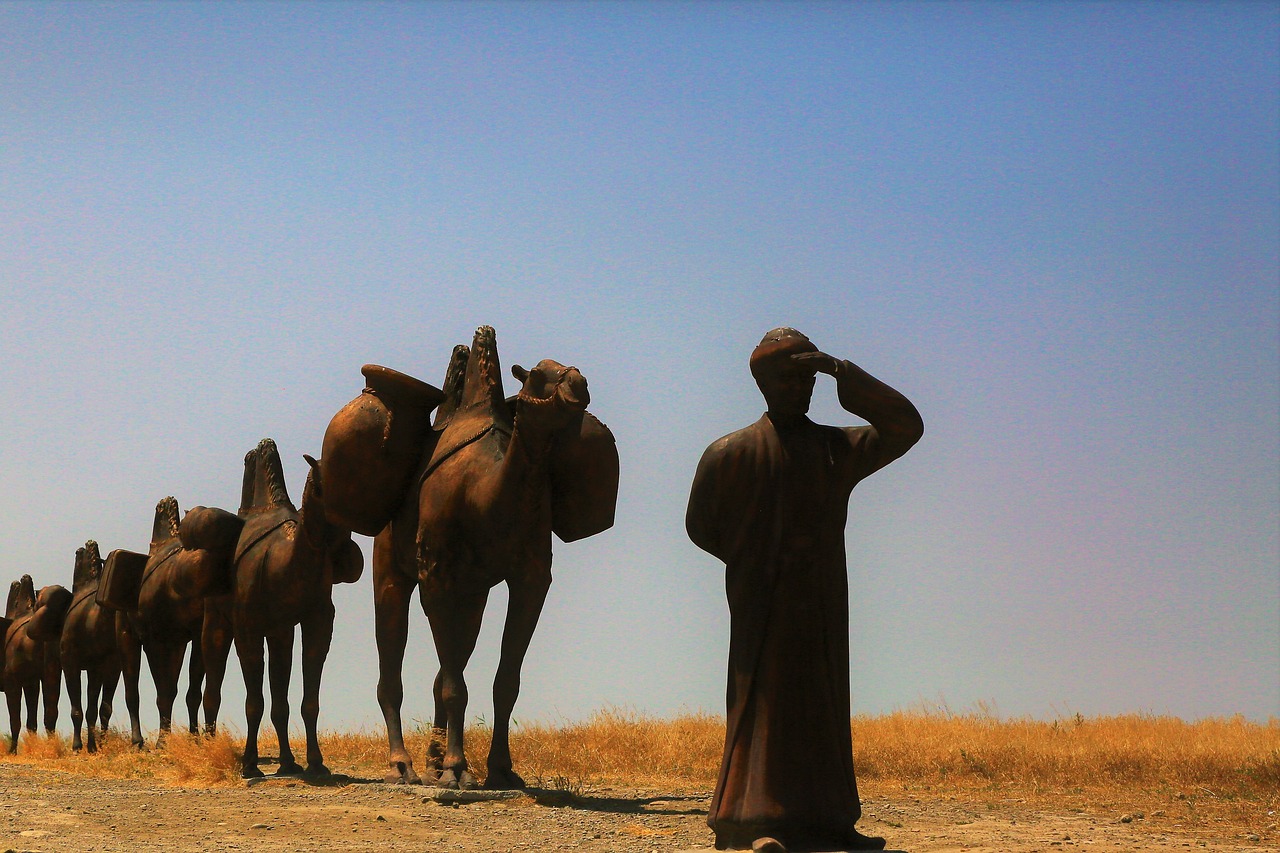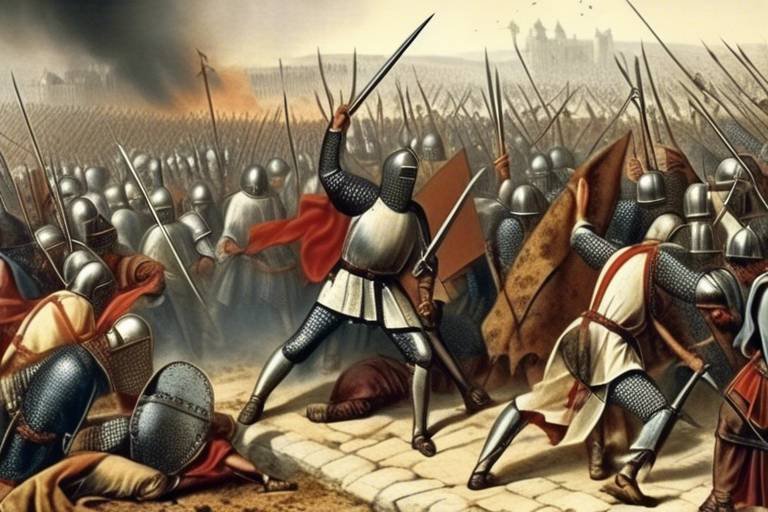The Importance of the Silk Road in Cultural Exchange
When exploring the significance of the Silk Road in cultural exchange, we delve into a historical tapestry woven with threads of trade, diplomacy, and intellectual discourse. This ancient network of routes connected the vibrant civilizations of the East and the West, serving as a conduit for the exchange of ideas, art, technology, and goods.
The Silk Road played a pivotal role in shaping the development of civilizations by facilitating interactions between diverse cultures such as China, India, Persia, and Rome. Through this interconnected web of trade routes, not only were silk and spices exchanged, but also knowledge, religious beliefs, and artistic influences that transcended geographical boundaries.
One of the most intriguing aspects of the Silk Road is its role in technological exchange. The transfer of innovations such as papermaking, printing, gunpowder, and compasses along these routes sparked advancements in various fields, revolutionizing the way people lived, communicated, and navigated the world.
Artistic expression flourished along the Silk Road as different styles, techniques, and motifs intermingled, giving rise to a rich tapestry of cultural fusion. Artists from diverse backgrounds shared their creativity, resulting in the creation of unique masterpieces that reflected the diversity and interconnectedness of the civilizations along the route.
Religious interactions also thrived on the Silk Road, with Buddhism, Christianity, Islam, and Zoroastrianism spreading through the exchange of ideas and beliefs. This religious diversity fostered tolerance, syncretism, and a shared understanding of spiritual practices, contributing to the cultural richness of the regions connected by the Silk Road.
Archaeological discoveries along the Silk Road continue to unveil the secrets of the past, offering glimpses into ancient cities, trade routes, and cultural artifacts. These findings provide valuable insights into the interconnected history of civilizations and the enduring legacy of the Silk Road in shaping the world as we know it today.
From an economic standpoint, the Silk Road played a crucial role in stimulating commerce, shaping global trade networks, and influencing the flow of luxury goods, spices, textiles, and other commodities. The exchange of these valuable items not only fueled economic growth but also fostered cultural exchange and mutual understanding among nations.
The legacy of the Silk Road lives on in the modern world, inspiring initiatives like the Belt and Road Initiative that aim to revive the spirit of cross-cultural cooperation and dialogue. By promoting international collaboration and understanding, the Silk Road continues to bridge gaps between nations and foster a sense of shared heritage and interconnectedness.
As we navigate the challenges and opportunities of the present day, preserving the cultural heritage of the Silk Road remains a priority. Sustainable tourism initiatives, coupled with efforts to leverage the historical significance of the Silk Road for mutual benefit, present opportunities for cultural enrichment and cross-cultural engagement in the 21st century.

Historical Significance
Exploring how the ancient Silk Road facilitated the exchange of ideas, culture, and goods between East and West, shaping the development of civilizations and influencing art, religion, technology, and more.
The Silk Road holds immense historical significance as it served as a vital network of trade routes connecting civilizations across Asia, Europe, and Africa. This ancient pathway not only facilitated the exchange of goods such as silk, spices, and precious metals but also played a crucial role in fostering diplomatic relations and cultural interactions between empires like China, India, Persia, and Rome.
Imagine a bustling marketplace where merchants from distant lands bartered exotic wares, scholars shared knowledge, and travelers embarked on epic journeys filled with adventure and discovery. The Silk Road was more than just a physical route; it was a bridge that spanned vast distances, linking diverse societies and shaping the course of history.
Through the Silk Road, ideas, languages, and customs were exchanged, leading to the transmission of innovations in agriculture, architecture, and governance. The interactions along this ancient trade route not only enriched the material wealth of civilizations but also nurtured a rich tapestry of cultural diversity that continues to influence our world today.

Technological Exchange
The along the ancient Silk Road played a pivotal role in shaping the development of civilizations through the transfer of knowledge and innovations across vast distances. Imagine a bustling marketplace where not only goods but also groundbreaking technologies like papermaking, printing, gunpowder, and compasses were exchanged like precious commodities. This exchange of technological marvels not only revolutionized industries but also paved the way for significant advancements in various fields.
One of the most remarkable technological contributions of the Silk Road was the introduction of papermaking to the Western world. Originating in China, the invention of paper revolutionized the way information was recorded and disseminated, fueling the spread of literacy and education. As this technology spread along the Silk Road, it laid the foundation for the flourishing of literature, art, and scholarship in distant lands.
The art of printing, another gift from the East, transformed the production of books and documents, making knowledge more accessible and enabling the mass dissemination of ideas. With the invention of movable type printing, the Silk Road became a conduit for the transmission of not only texts but also cultural and scientific knowledge, fostering intellectual exchange and innovation.
Gunpowder, a revolutionary invention with explosive potential, was another technological marvel that traveled along the Silk Road, forever changing the nature of warfare and shaping the course of history. The discovery of gunpowder in China and its diffusion to the West through trade routes heralded a new era of military tactics, fortifications, and weaponry, altering the balance of power and the conduct of conflicts.
Compasses, the navigational instruments that revolutionized maritime exploration and trade, also found their way from China to distant lands through the Silk Road. By enabling sailors to navigate with precision using the Earth's magnetic field, compasses opened up new horizons for trade, travel, and cultural exchange, connecting civilizations across vast oceans and continents.

Artistic Influence
Exploring how the ancient Silk Road facilitated the exchange of ideas, culture, and goods between East and West, shaping the development of civilizations and influencing art, religion, technology, and more.
The Silk Road was not just a route for the exchange of goods but also a pathway for the flow of artistic inspiration and creativity. Imagine a vast canvas where different cultures painted their stories, blending colors and techniques to create a masterpiece of cultural fusion.
Artistic styles and motifs traveled along the Silk Road like messengers of creativity, inspiring artists in distant lands to experiment with new forms and expressions. From intricate patterns of Persian carpets to the delicate brushstrokes of Chinese landscapes, the Silk Road became a melting pot of artistic traditions.
Imagine a marketplace where artisans from different corners of the world gathered, each bringing their unique craftsmanship and creativity to trade and share. The Silk Road not only facilitated the exchange of physical artworks but also sparked a cultural dialogue that transcended language barriers and borders.
Through this artistic exchange, new techniques were born, and traditional methods were revitalized. The intricate metalwork of the Byzantine Empire influenced the designs of Islamic calligraphy, while Indian textiles inspired patterns in European tapestries. The Silk Road became a living museum of artistic evolution, where each brushstroke told a story of cultural interconnectedness.
As travelers journeyed along the Silk Road, they carried with them not only goods but also artistic inspiration. The fusion of styles and ideas led to the creation of unique art forms that reflected the diverse influences of the civilizations connected by this ancient trade route.
The legacy of artistic exchange along the Silk Road continues to inspire contemporary artists, who draw upon the rich tapestry of cultural heritage woven by centuries of cross-cultural interaction. Just as the Silk Road once connected distant lands through art, today, it serves as a reminder of the power of creativity to transcend boundaries and unite humanity in a shared appreciation of beauty.
- What was the main purpose of the Silk Road?
- How did the Silk Road influence art and culture?
- What were some of the key artistic traditions exchanged along the Silk Road?
- How did the Silk Road impact the development of artistic techniques?
- What is the significance of the Silk Road in contemporary art?

Religious Interactions
Religious interactions along the Silk Road played a pivotal role in shaping the spiritual landscape of the ancient world. The vast network of trade routes not only facilitated the exchange of goods but also served as a conduit for the spread of diverse religious beliefs. Religions such as Buddhism, Christianity, Islam, and Zoroastrianism found fertile ground for dissemination, leading to a rich tapestry of religious diversity and syncretism.
One of the most significant impacts of religious interactions on the Silk Road was the transmission of Buddhism from India to Central Asia and beyond. Monasteries and stupas along the trade routes served as centers of learning and spiritual practice, attracting pilgrims and scholars from different regions. The blending of Buddhist teachings with local traditions gave rise to unique artistic expressions, such as the Gandhara art style that combined Hellenistic and Indian influences.
Similarly, the spread of Christianity along the Silk Road brought about cultural exchanges and theological debates between East and West. Nestorian Christians from the Byzantine Empire ventured eastward, establishing communities in Persia, Central Asia, and even China. The translation of religious texts and the adaptation of Christian iconography to local artistic traditions enriched the cultural landscape of the Silk Road.
Islam, with its message of unity and submission to the divine, also found resonance among the diverse populations traversing the Silk Road. The establishment of Islamic caliphates in regions such as Persia and Central Asia facilitated the integration of Islamic principles with existing belief systems, leading to the development of unique architectural styles and cultural practices.
Zoroastrianism, an ancient Persian religion centered on the dualistic struggle between good and evil, also left its mark on the Silk Road. Zoroastrian fire temples dotted the trade routes, serving as beacons of spiritual guidance and community gathering. The syncretic nature of Zoroastrianism allowed for harmonious coexistence with other faiths, fostering a spirit of religious tolerance and mutual respect.
Overall, the religious interactions along the Silk Road not only influenced the spiritual beliefs of the people but also contributed to the cultural and artistic exchange between civilizations. The legacy of these interactions can still be seen in the architectural marvels, religious artifacts, and shared rituals that bear witness to the interconnectedness of human experience across time and space.

Archaeological Discoveries
Along the ancient Silk Road, a treasure trove of archaeological discoveries awaits, shedding light on the vibrant interactions and exchanges that took place between East and West. These findings not only reveal the material remnants of the past but also provide invaluable insights into the interconnected history of civilizations.
Excavations along the Silk Road have unearthed ancient cities that once thrived as bustling hubs of trade and cultural exchange. From the majestic ruins of Xi'an in China to the well-preserved remnants of Palmyra in Syria, these archaeological sites offer a glimpse into the urban centers that flourished along the trade routes.
Trade routes lined with caravanserais, where merchants and travelers sought rest and refuge, have also been discovered, showcasing the infrastructure that supported the flow of goods and ideas across vast distances. These waypoints of the past serve as tangible reminders of the commercial activities that sustained the Silk Road network.
Artifacts found along the Silk Road provide tangible evidence of the diverse goods that were traded between civilizations. From intricately crafted pottery and exquisite textiles to precious metals and exotic spices, these objects speak volumes about the luxury items that fueled commerce and cultural exchange.
Cultural relics discovered along the Silk Road offer a glimpse into the artistic, religious, and technological innovations that shaped societies along the trade routes. Buddhist cave temples adorned with intricate murals, ancient manuscripts revealing the transmission of knowledge, and innovative tools and instruments attest to the rich tapestry of human creativity and ingenuity.
Through the preservation and study of these archaeological discoveries, researchers and historians continue to unravel the mysteries of the Silk Road and piece together the intricate web of connections that linked civilizations in a shared journey of discovery and exchange.

Economic Impact
When delving into the historical significance of the Silk Road, one cannot overlook its profound . This ancient network of trade routes not only connected the East and the West but also played a pivotal role in shaping the global economy. The Silk Road served as a conduit for the exchange of a myriad of goods, ranging from luxurious silk and spices to everyday items like textiles and ceramics.
One of the key aspects of the economic impact of the Silk Road was its role in stimulating commerce and fostering trade networks that spanned vast distances. Merchants and traders from diverse cultures and regions converged along these routes, engaging in transactions that not only enriched themselves but also contributed to the overall prosperity of the societies they represented.
Moreover, the Silk Road facilitated the flow of innovations and technologies that revolutionized various industries. The introduction of new goods and techniques, such as papermaking, printing, and the compass, not only enhanced productivity but also fueled further economic growth and development.
Furthermore, the exchange of precious commodities along the Silk Road not only generated wealth but also fueled demand and consumption patterns in distant lands. The allure of exotic goods from faraway lands spurred a thriving market for luxury items, creating a demand that transcended borders and cultures.
In essence, the economic impact of the Silk Road was far-reaching and transformative, laying the foundation for the interconnected global economy that we see today. The legacy of this ancient trade network continues to inspire economic cooperation and collaboration across nations, fostering mutual benefit and prosperity.

Legacy and Revival
Exploring how the ancient Silk Road facilitated the exchange of ideas, culture, and goods between East and West, shaping the development of civilizations and influencing art, religion, technology, and more.
The legacy of the Silk Road continues to resonate through the annals of history, weaving a tapestry of cross-cultural connections that transcend time and space. Its revival in contemporary discourse serves as a beacon of inspiration, igniting modern initiatives like the Belt and Road Initiative, aimed at revitalizing ancient trade routes and fostering international cooperation.
The Silk Road's enduring legacy lies not only in the physical remnants of its past glory but also in the intangible threads of cultural exchange that have woven a rich tapestry of diversity and understanding. Through the revival of its spirit, nations are coming together once again, not only to trade goods but also to share knowledge, art, and traditions.
As the Silk Road is resurrected in the modern era, it presents a myriad of opportunities for nations to engage in dialogue, collaboration, and mutual enrichment. The legacy of this ancient network of trade routes serves as a reminder of the power of cultural exchange to bridge divides, foster understanding, and pave the way for a more interconnected world.
Stay tuned for some frequently asked questions about the Silk Road and its impact on cultural exchange!

Challenges and Opportunities
Exploring how the ancient Silk Road facilitated the exchange of ideas, culture, and goods between East and West, shaping the development of civilizations and influencing art, religion, technology, and more.
As we delve into the legacy of the Silk Road, we encounter both challenges and opportunities in preserving its rich cultural heritage. One of the primary challenges lies in the preservation of the ancient sites and artifacts scattered along the historic route. Balancing the need for tourism and economic development with the conservation of these invaluable treasures poses a significant dilemma.
Furthermore, ensuring sustainable tourism practices that respect the environment and local communities is crucial for the long-term viability of Silk Road destinations. By promoting responsible travel and cultural awareness, we can safeguard these sites for future generations to appreciate and learn from.
On the other hand, the Silk Road presents a myriad of opportunities for cultural exchange and economic growth. Reviving the ancient trade routes through modern infrastructure projects, such as the Belt and Road Initiative, opens up new possibilities for cross-border cooperation and development.
By leveraging the historical significance of the Silk Road, countries along the route can enhance connectivity, foster dialogue, and promote mutual understanding. This revival not only honors the legacy of the past but also paves the way for a more interconnected and prosperous future.
Stay tuned for answers to commonly asked questions about the Silk Road and its enduring impact on global history and culture.
Frequently Asked Questions
- What is the Silk Road?
The Silk Road was an ancient network of trade routes that connected the East and West, enabling the exchange of goods, ideas, and culture between different civilizations.
- How did the Silk Road impact cultural exchange?
The Silk Road played a crucial role in shaping the development of civilizations by facilitating the spread of technologies, artistic styles, religions, and economic activities across regions.
- Which civilizations were connected by the Silk Road?
The Silk Road connected civilizations such as China, India, Persia, and Rome, fostering diplomatic relations, trade partnerships, and the sharing of knowledge and innovations.
- What were some of the key technologies exchanged on the Silk Road?
Technologies such as papermaking, printing, gunpowder, and compasses were exchanged along the Silk Road, contributing to advancements in various fields and enhancing cross-cultural interactions.
- How did the Silk Road influence artistic expressions?
The Silk Road facilitated the exchange of artistic styles, techniques, and motifs, leading to the fusion of diverse artistic traditions and the creation of unique cultural expressions that reflected the interactions between different societies.
- What religions were spread through the Silk Road?
Religions such as Buddhism, Christianity, Islam, and Zoroastrianism were spread along the Silk Road, promoting religious tolerance, syncretism, and the enrichment of cultural diversity.
- What is the modern significance of the Silk Road?
The legacy of the Silk Road continues to promote cross-cultural understanding, inspire initiatives like the Belt and Road Initiative, and foster international cooperation and dialogue for mutual benefit and cultural enrichment.
- What are the challenges in preserving the heritage of the Silk Road?
Contemporary challenges include sustainable tourism, conservation of archaeological sites, and ensuring the protection of cultural relics along the Silk Road to maintain its historical significance for future generations.



















